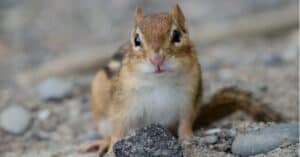Chipmunks are solitary animals, typically interacting physically during mating season and when caring for offspring. However, they make various vocalizations used to communicate with their colonies.
Most of the sounds a chipmunk makes, like chips, chucks, trills, and chits, are used to warn other chipmunks of predators. Male chipmunks call out to females during mating season with a combination of croaks and chips.
Learn what these sounds are, how to identify them, and even more about chipmunk identification below!
What Sounds do Chipmunks Make?

Chipmunks chip to warn others of predators on the ground.
©Skyler Ewing/Shutterstock.com
Chipmunks make a few different sounds. These sounds include:
- Chips
- Chucks
- Trills
- Croaks
- Chits
Chipmunks chip loudly when a predator is nearby. This seems to be primarily used for ground predators, though not exclusively—it can mean birds of prey are in the area as well. The call warns other chipmunks nearby of the threat. The sound of a chipping chipmunk (say that three times fast!) is high-pitched and sometimes mistaken for a bird. It may last seconds to minutes and is a repetitive call.
Chucking serves a similar purpose but seems to be used only for predatory birds. When chipmunks chuck, they make a low-pitched clucking sound.
Not only do these two sounds let nearby chipmunks know to burrow underground, but they also let sneaky predators know the chipmunks are on to them. Certain predators, such as cats, are less likely to attack once they know they’ve been spotted. They’ll instead move on to easier, less observant prey.
While chips and chucks are repetitive, trills consist of just one or two noises that are different from one another. Chipmunks trill when a predator is chasing them. If they’re near their home burrow that contains their family members, chipmunks may even trill more or louder to ensure they hear.
Males use croaks in combination with chips to attract females. Mating is the only time chipmunks tend to interact with one another apart from their frequent calls; they seem to care about one another but also prefer their territories!
Lastly, chipmunks make a very high-pitched sound known as a chit when they are surprised by something.
Why do Chipmunks Chirp so Loud?
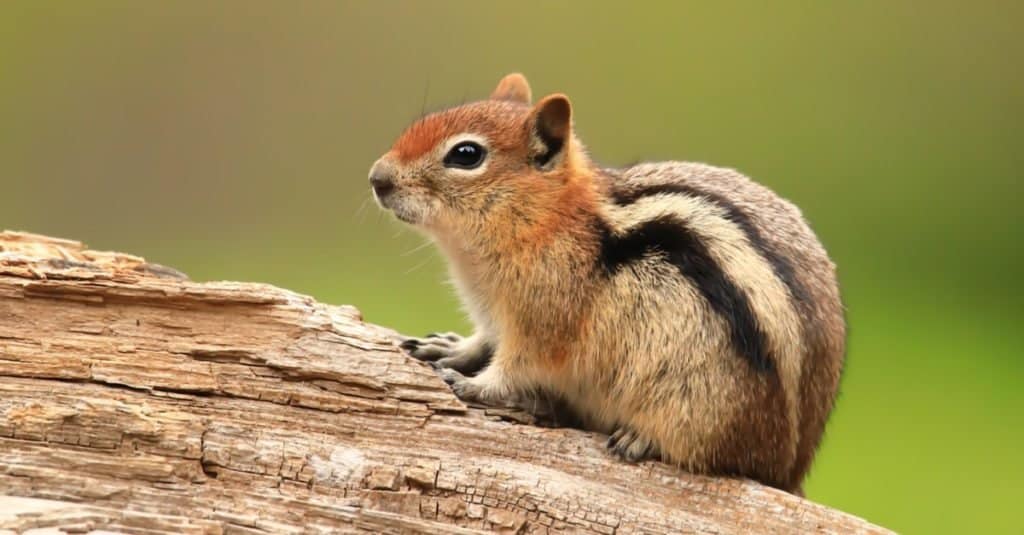
Chucks are used to warn the colony of aerial predators.
©AmberLouise/Shutterstock.com
Why do chipmunks chirp? If you hear a loud, chirping noise from a chipmunk, they’re most likely chipping, also known as “chip-chips” due to their repetitive nature. These loud calls mean a predator is nearby, and the chipmunk is warning its colony so that they aren’t eaten! The other chipmunks react by either hiding underground or becoming more alert in their behaviors.
Another reason why chipmunks chirp so loud is if they are defending their burrows. Chipmunks will loudly defend the area surrounding their burrows with various chips and chucks. They are territorial and solitary animals, so although they live in colonies, they depend on their own space.
Chipmunks have been known to spend up to half an hour chipping and chucking to warn others away from their homes and may even resort to aggression if their vocalizations don’t work.
Do Chipmunks Make a Knocking Sound?
Some people mistake a chipmunk’s chucks for a knocking sound. You might hear this when there are birds of prey in the air. However, you might also be hearing another animal like a woodpecker!
Why Do Chipmunks Chirp and are They Active at Night?
Chipmunks are diurnal, so you shouldn’t hear them at night. You’re likely hearing another animal and confusing its noise with that of a chipmunk!
For instance, some people suspect they have chipmunks in their homes or garages. They may hear the animal moving around at night or notice poop pellets collecting as they sleep. In this case, you’re likely confusing a chipmunk with a rat or mouse.
Chipmunk Tracks and Droppings
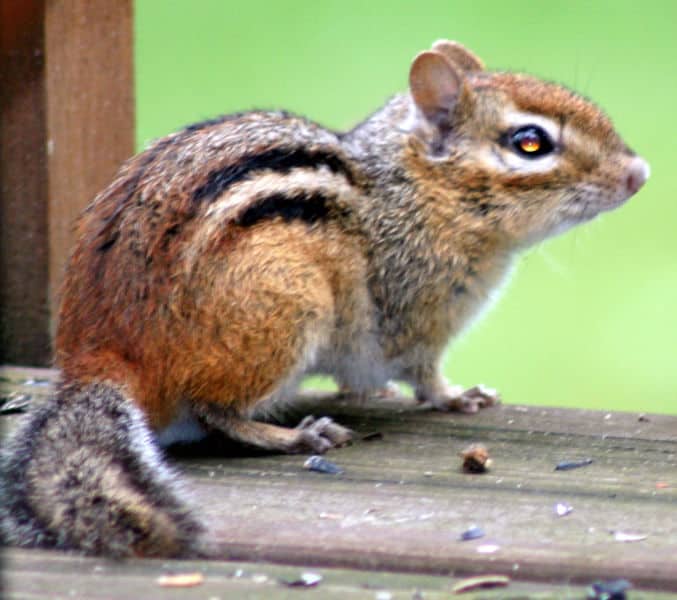
Other ways to identify chipmunks are by their tracks or looking for collections of droppings.
©R. A. Nonenmacher, CC BY-SA 3.0, via Wikimedia Commons – License
If you suspect you have chipmunks in your home or yard, you might be looking for various ways to identify them.
First, chipmunk droppings are less than a centimeter in length. Depending on what a chipmunk eats, the droppings will be brown to black. The pellets are tapered at each end and look similar to mouse and rat droppings. However, there’s one major difference: chipmunks don’t like to poop out in the open. They tend to hide their feces from predators and typically only poop underground in a special chamber of their burrows. Occasionally, they might poop while away from home. In this case, you’ll find the droppings in one central location that the chipmunk returns to continuously.
Chipmunk tracks appear in clusters, like squirrel tracks. This is because chipmunks kind of hop forward as they move. You may notice a crescent shape facing away from the toes and five small claw marks in a perfect chipmunk track. However, it’s more common to have difficulty seeing the claw marks as they’re held so close together on a chipmunk’s tiny foot.
Of course, chipmunk footprints are smaller than squirrel tracks.
Bonus: What Does a Chipmunk Burrow Look Like?
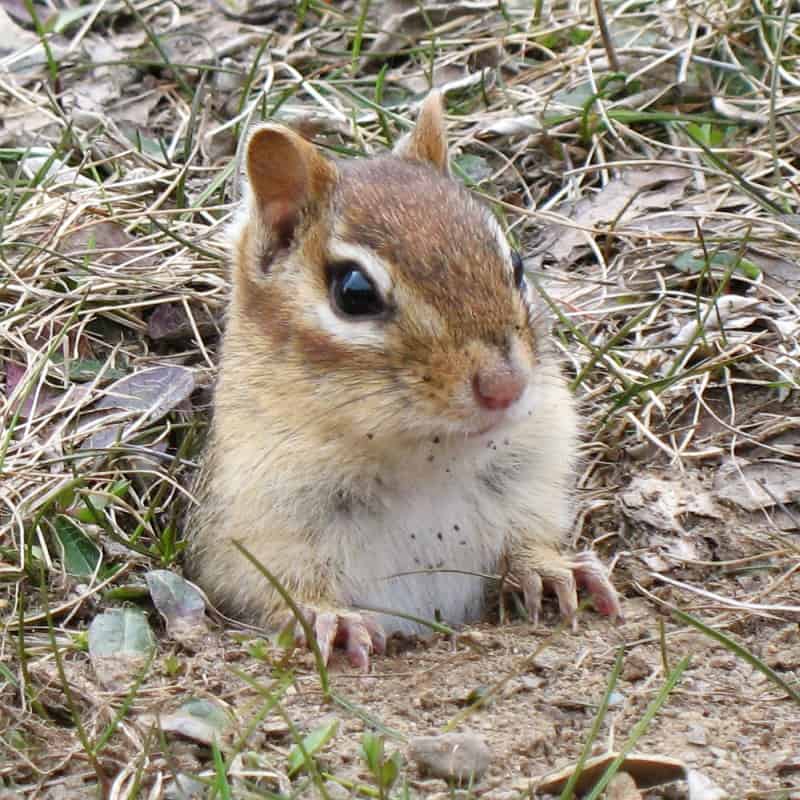
Chipmunks live in underground burrows that they dig themselves.
©Gilles Gonthier / CC By 2.0 – License
Now that you have learned to identify chipmunk sounds – you may wonder what their burrows are like. Chipmunks build complex homes with several entrances that are 2 – 3 inches in diameter. Unlike mole or ant holes that have mounds of dirt – a chipmunk entrance is neat, tidy, and flat to the ground. These clever rodents also build plunge holes that go to tunnels that lead straight down.
There are separate chambers in the burrow for food storage, going potty, and a birthing room. Those chambers usually surround the main room where the chipmunk sleeps. These little architects also dig drainage tunnels under the burrow to collect water so their home remains dry and cozy. Some chipmunks have multiple burrows and quick hide-outs for escaping predators. Chipmunks are like their hamster cousins who prefer to live on their own. The only time they share their homes is when they are raising their pups.
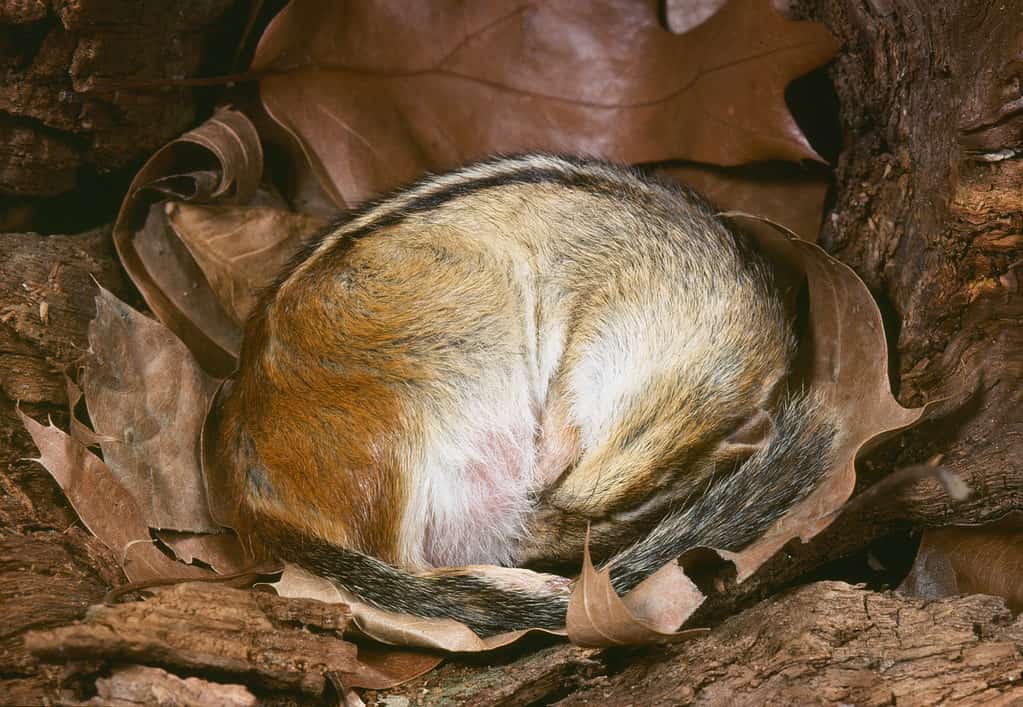
The inside of a chipmunk burrow contains leaves and nesting material for cozy sleeping.
©Breck P. Kent/Shutterstock.com
The photo featured at the top of this post is © Cindy Larson/Shutterstock.com
Thank you for reading! Have some feedback for us? Contact the AZ Animals editorial team.





